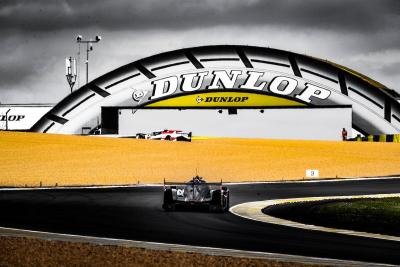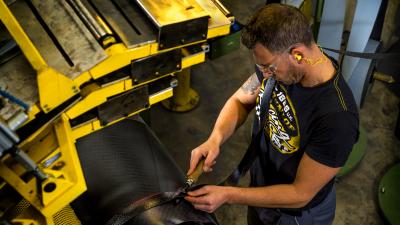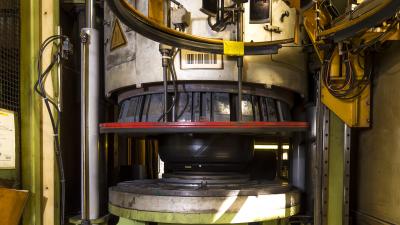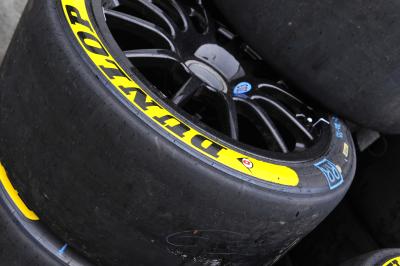The winning formula that keeps Dunlop on top
Having just celebrated its 130th Birthday on June 14, British tyre manufacturer Dunlop heads into this year’s 24 Hours of Le Mans this weekend looking to claim an eighth consecutive victory at the Circuit de la Sarthe.
Dunlop’s association with the prestigious race can be charted all the way back to its first win in 1924, with its yellow-clad branding ever-present at the 8.469s mile long circuit following the inclusion of a corner named after the famous Dunlop bridge, which remains the oldest surviving example of an advertising footbridge.
Having just celebrated its 130th Birthday on June 14, British tyre manufacturer Dunlop heads into this year’s 24 Hours of Le Mans this weekend looking to claim an eighth consecutive victory at the Circuit de la Sarthe.
Dunlop’s association with the prestigious race can be charted all the way back to its first win in 1924, with its yellow-clad branding ever-present at the 8.469s mile long circuit following the inclusion of a corner named after the famous Dunlop bridge, which remains the oldest surviving example of an advertising footbridge.
The desire to win goes back even further and has been ingrained into Dunlop’s DNA ever-since founder John Boyd Dunlop pioneered the first competition pneumatic tyre in the late 1800s. Over a century later and Dunlop continues to push the boundaries as one of the leading tyre manufacturers in the world.
Dunlop supplies tyres to a number of motorsport championships across both two and four wheels, including major competitions such as the FIA World Endurance Championship, British Touring Car Championship, European Le Mans Series, Moto 2 and Moto 3 and the Isle of Man TT.
That all adds up to a presence at over 300 races across the globe each year. Dunlop leads a four-way operation in order to stay on top of the game, which comprises of manufacturing plants in both Hanau, Germany and Montlucon, France, with additional research and development labs located in Birmingham and Luxembourg - the latter of which houses Dunlop’s centre of excellence, where its scientists and chemists are primarily based.
Managing such a complex operation while continuing to churn out high quality tyres on a consistent basis requires a “considerable effort”, as explained by Dunlop’s communications director James Bailey.
“Sometimes the operational side is even more interesting than the manufacturing side. This is an interesting management challenge and it shows as a company how we collaborate across boarders and operate as one team,” Bailey said.
“We have trucks based here, in the UK, and in central France. We also use partner-dealers in countries when its a national championship for example. It’s a considerable effort to service 300 races a year.
“In Birmingham we’ve got research and development, a lot of the tyre design is done in Birmingham, particularly for motorcycle tyres. We also have our service engineering crew, so when you see the team that are working in the pitlane who are checking and monitoring the cambers the pressures and the set ups of the cars.”
2017 was a huge success story for Dunlop. In total, it recorded six 24 Hour race victories that featured open tyre competition, including its seventh straight LMP2 win at Le Mans, Le Mans GTE class, the 24 Hours Nurburgring, the 24 Hours of Le Mans motorcycle race, the Bol D’Or 24 Hours and 24 Heures de Catalunya.
At the 24 Hours of Le Mans alone, Dunlop tyres led a total of 769 laps, including every lap in LMP2 with the top 36 runners in that class all using tyres constructed and supplied from Hanau. Not only did Dunlop’s 2017 tyre range last the distance, they smashed the race lap times set the previous year. The fastest LMP2 race lap was a full 8.5 seconds quicker than in 2016.
“2017 was a strong season for us,” Bailey added. “That kind of endurance racing, we don’t just do it to win, we do it to learn. The rule to have only three people working on the car, it’s a very clever rule from the ACO, because just by limiting the amount of people who can work on the car, it forces the tyre manufacturer to focus not only on performance but also longevity as well.
“Four stints at Le Mans is about the same distance as two and a half [Formula 1] grand prix. It’s one thing to make a durable tyre but that tyre has to be performing within the same window of that performance as well. It’s that quality and durability that is helping us to win the race.”
The secrets behind Dunlop winning formula are hidden behind the walls of its 125-year-old Hanau factory, situated in the industrial heartlands on the outskirts of Frankfurt. Here, Dunlop churns out 70,000 fresh tyres per day with its 1,450-strong manufacturing team.
Each tyre goes through a highly labour intensive 16-stage process, the majority of which is undertaken at Hanau in a procedure lasting between 80-90 minutes from the manual fabric and carcass manufacture right through to compound mixing, moulding and curing to form the final tyre shape. This is concluded with a manual inspection on every single tyre to ensure quality control before shipping commences.
The complex procedure is highlighted by the use of 14 materials - made up of a range of artificial polymers and fillers - in the carcass alone to provide sufficient performance and consistency across its tyre compounds. During the process, considerations have to be taken into account for the varying requirements of each championship.
In its 15th year of supplying the BTCC, the UK’s premier touring car championship will celebrate its 60th season with a 60-mile race at Snetterton. However, the event will not use a special tyre, providing Dunlop with an added challenge given the longer-than-usual race distance. Meeting the requirements of its clients is an area the British manufacturer excels in, with Dunlop also needing to tailor its tyres to meet the specific demands of its WEC customers.
Dunlop takes quality control incredibly seriously, with Bailey dubbing its tyre manufacturing as making “the fastest tyres in the slowest process”. As a result, it holds an impressive reliability record. On the rare occasions disaster does strike, such as at the Thruxton round of the 2016 BTCC campaign, Dunlop ships its tyres back to its Hanau factory for a post-mortem.
Following a series of tyre dramas at the Hampshire circuit, Dunlop ultimately concluded that just one tyre (out of over 500 used that weekend) had been a complete structural failure, suggesting temperatures, track conditions and car set-up had the most prominent impact.
While we can all be guilty on occasions of overlooking and undervaluing the role tyres play in motor racing, Dunlop’s intricacies and working methods demonstrate the hard work that goes on behind the scenes. It’s how four - or indeed two - circular pieces of black rubber can make the difference.














